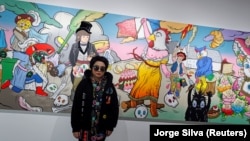In some countries, there would not be any problem with art showing French revolutionaries replaced with cartoon cats and birds. But it may be a sensitive subject for Thailand's monarchy.
For artist Yuree Kensaku, the country’s political situation shapes her work. Protesters in Thailand are calling for reform of the monarchy and other changes.
"People have started their political awakening," said Kensaku.
The Bangkok Art Biennale is now showing her latest artwork. It combines the influences of her Thai background with her experience making art in La Rochelle, France. There, historical works of art showing times of revolution gave her the ideas she uses now.
Talk of revolution is sensitive in Thailand. People loyal to the monarchy say that protesters are trying to bring down that system of government. Supporters of the king think protesters are calling for reforms to limit his powers. But the protest leaders say that is not their goal. The protesters want to remove Prime Minister Prayuth Chan-ocha and establish a new constitution.
Kensaku’s parents are Thai and Japanese. She was born and raised in Bangkok. She said her work is not meant to be a message about the monarchy.
"We must learn about the past to understand the present but I'm not saying that we have to go that way necessarily," she said.
Kensaku does not believe that reforms will end the Thai monarchy.
Blue, Blanc, Rouge
In the middle of one large Kensaku work, a female body with the head of a chicken holds a flag of blue, white and red. It is similar to Frenchman Eugene Delacroix's 1830 painting Liberty Leading the People. In Delacroix's work, a woman representing Liberty holds the French flag high over bodies of fighters at her feet. The painting depicts France's July Revolution of 1830.
Kensaku’s piece is called Blue, Blanc, Rouge. It relates to both the French and Thai flags, which use the colors blue, white and red. In France’s flags the colors represent freedom, equality and friendship. In Thailand, they stand for monarchy, religion and nation.
Broken Victoria
Kensaku’s other work at the biennale is a sculpture titled "Broken Victoria." It is modeled on the Winged Victory of Samothrace, an ancient piece at the Louvre museum in Paris.
Kensaku’s work combines a winged female body with the head of a cat with green hair. The cat-woman holds a revolutionary flag above her head. A white tie around its middle suggests a symbol of the Thai protests, Kensaku said. And the cat-woman’s wing is broken.
She noted that protestors can get hurt. "In order to achieve victory you have to fight for it and it's not going to be easy," she said.
Kensaku said the indirect symbolism she uses made it possible to show her work in public without risk of trouble from Thai officials. Speaking out against the country’s monarchy directly can lead to a jail sentence.
The artist said, "The nature of my work is already self-censoring because it is hiding the truth behind it. It's less risky than other artists out there."
I’m Jill Robbins.
Jorge Silva reported on this story for Reuters. Jill Robbins adapted it for Learning English. Caty Weaver was the editor.
___________________________________________________________
Words in This Story
cartoon - n. a drawing in a newspaper or magazine intended as a humorous comment on something
monarchy – n. a form of government in which a country is ruled by a monarch
sculpture – n. a piece of art that is made by carving or molding clay, stone or metal
symbol – n. an action, object or event that expresses or represents a particular idea or quality
achieve – v. to get or reach (something) by working hard











